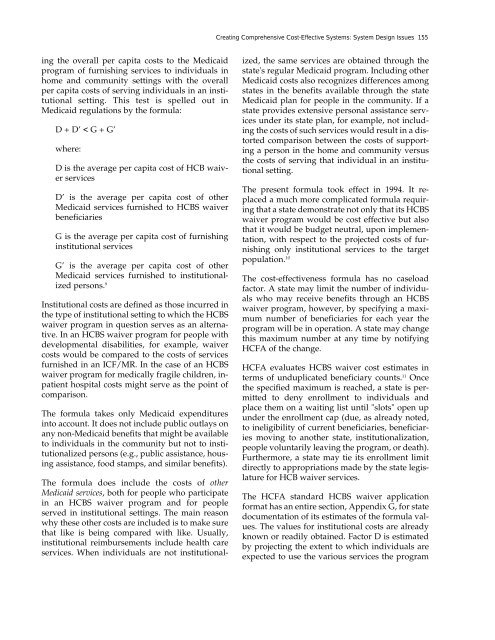Full PDF Version - ASPE - U.S. Department of Health and Human ...
Full PDF Version - ASPE - U.S. Department of Health and Human ...
Full PDF Version - ASPE - U.S. Department of Health and Human ...
- No tags were found...
Create successful ePaper yourself
Turn your PDF publications into a flip-book with our unique Google optimized e-Paper software.
Creating Comprehensive Cost-Effective Systems: System Design Issues 155ing the overall per capita costs to the Medicaidprogram <strong>of</strong> furnishing services to individuals inhome <strong>and</strong> community settings with the overallper capita costs <strong>of</strong> serving individuals in an institutionalsetting. This test is spelled out inMedicaid regulations by the formula:D + D’ < G + G’where:D is the average per capita cost <strong>of</strong> HCB waiverservicesD’ is the average per capita cost <strong>of</strong> otherMedicaid services furnished to HCBS waiverbeneficiariesG is the average per capita cost <strong>of</strong> furnishinginstitutional servicesG’ is the average per capita cost <strong>of</strong> otherMedicaid services furnished to institutionalizedpersons. 9Institutional costs are defined as those incurred inthe type <strong>of</strong> institutional setting to which the HCBSwaiver program in question serves as an alternative.In an HCBS waiver program for people withdevelopmental disabilities, for example, waivercosts would be compared to the costs <strong>of</strong> servicesfurnished in an ICF/MR. In the case <strong>of</strong> an HCBSwaiver program for medically fragile children, inpatienthospital costs might serve as the point <strong>of</strong>comparison.The formula takes only Medicaid expendituresinto account. It does not include public outlays onany non-Medicaid benefits that might be availableto individuals in the community but not to institutionalizedpersons (e.g., public assistance, housingassistance, food stamps, <strong>and</strong> similar benefits).The formula does include the costs <strong>of</strong> otherMedicaid services, both for people who participatein an HCBS waiver program <strong>and</strong> for peopleserved in institutional settings. The main reasonwhy these other costs are included is to make surethat like is being compared with like. Usually,institutional reimbursements include health careservices. When individuals are not institutionalized,the same services are obtained through thestate's regular Medicaid program. Including otherMedicaid costs also recognizes differences amongstates in the benefits available through the stateMedicaid plan for people in the community. If astate provides extensive personal assistance servicesunder its state plan, for example, not includingthe costs <strong>of</strong> such services would result in a distortedcomparison between the costs <strong>of</strong> supportinga person in the home <strong>and</strong> community versusthe costs <strong>of</strong> serving that individual in an institutionalsetting.The present formula took effect in 1994. It replaceda much more complicated formula requiringthat a state demonstrate not only that its HCBSwaiver program would be cost effective but alsothat it would be budget neutral, upon implementation,with respect to the projected costs <strong>of</strong> furnishingonly institutional services to the targetpopulation. 10The cost-effectiveness formula has no caseloadfactor. A state may limit the number <strong>of</strong> individualswho may receive benefits through an HCBSwaiver program, however, by specifying a maximumnumber <strong>of</strong> beneficiaries for each year theprogram will be in operation. A state may changethis maximum number at any time by notifyingHCFA <strong>of</strong> the change.HCFA evaluates HCBS waiver cost estimates interms <strong>of</strong> unduplicated beneficiary counts. 11 Oncethe specified maximum is reached, a state is permittedto deny enrollment to individuals <strong>and</strong>place them on a waiting list until "slots" open upunder the enrollment cap (due, as already noted,to ineligibility <strong>of</strong> current beneficiaries, beneficiariesmoving to another state, institutionalization,people voluntarily leaving the program, or death).Furthermore, a state may tie its enrollment limitdirectly to appropriations made by the state legislaturefor HCB waiver services.The HCFA st<strong>and</strong>ard HCBS waiver applicationformat has an entire section, Appendix G, for statedocumentation <strong>of</strong> its estimates <strong>of</strong> the formula values.The values for institutional costs are alreadyknown or readily obtained. Factor D is estimatedby projecting the extent to which individuals areexpected to use the various services the program
















